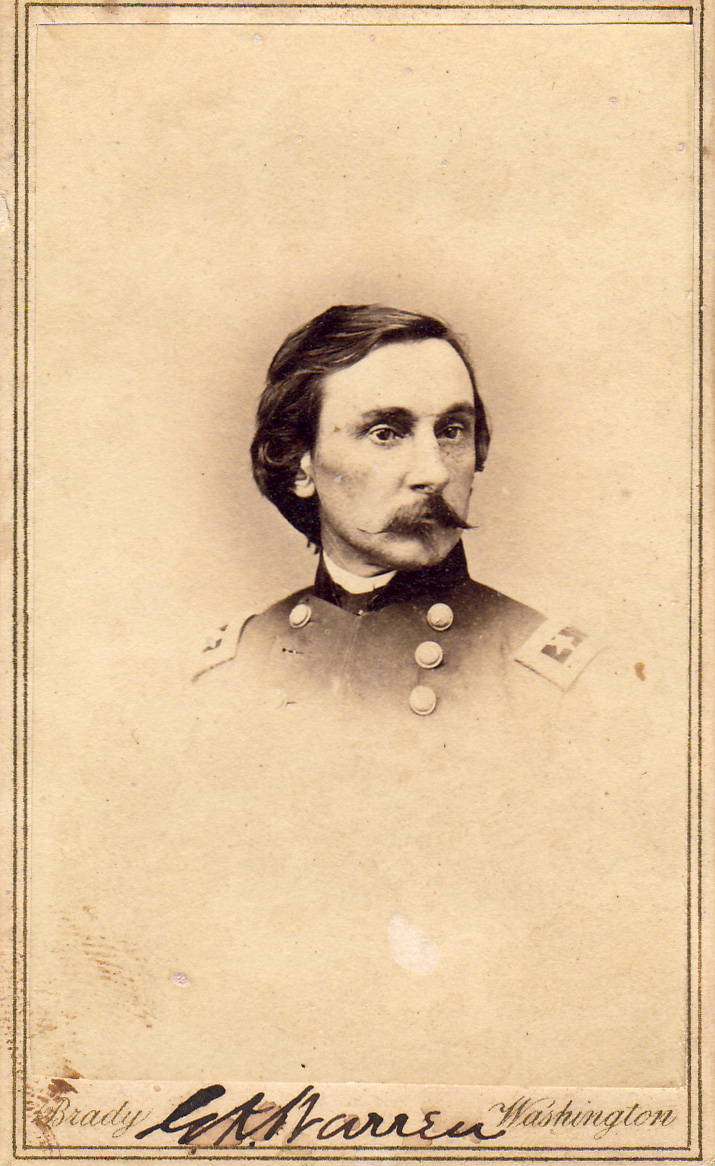 Gouverneur Warren was born into a prominent family at Cold Spring, New York. Graduating second in the 1850 class of the U.S. Military Academy, he entered the Corps of Topographical Engineers as a brevet second lieutenant. His first duties included surveying the Mississippi River delta and leading studies for the improvement of the Rock Island and Des Moines rapids on the upper Mississippi
Gouverneur Warren was born into a prominent family at Cold Spring, New York. Graduating second in the 1850 class of the U.S. Military Academy, he entered the Corps of Topographical Engineers as a brevet second lieutenant. His first duties included surveying the Mississippi River delta and leading studies for the improvement of the Rock Island and Des Moines rapids on the upper Mississippi
In 1854 Warren was assigned to the Office of Pacific Railroad Explorations and Surveys, which scouted potential routes for railroads from the Mississippi to the West Coast. Warren had the challenging task of preparing a comprehensive map of the Trans-Mississippi West based on maps made by the railroad surveys and earlier western surveys. While engaged in this demanding work, Warren was also performing topographic work for an expedition into the Sioux country, where he experienced his first combat at the Battle of Ash Hollow. In 1857 he completed the comprehensive map, a cartographic masterpiece that for the first time provided a detailed and accurate depiction of the western half of the United States.
The Civil War erupted while Warren was teaching mathematics at West Point. He accepted a commission as lieutenant colonel of the Fifth New York Regiment. Soon after, he was promoted to colonel and commander of the regiment. He led a brigade in the Peninsula Campaign and was wounded at Gaines’s Mill. After combat at the Second Battle of Bull Run, he participated in the battle of Antietam. In September of 1862 he was promoted to brigadier general of volunteers; earlier he had been made a captain in the Corps of Topographical Engineers. He became Chief Topographical Engineer of the Army of the Potomac early in 1863. In May of that year he was elevated to major general of volunteers, and at year’s end he participated in the Battle of Fredericksburg. Meanwhile, the Corps of Topographical Engineers was merged with the Corps of Engineers.
At the Battle of Gettysburg, as Chief Engineer of the Army of the Potomac, Warren gained his greatest military fame. With what is credited as his topographer’s eye, he saw that Little Round Top was undefended and in danger of being captured by Confederate forces that could roll up the Union left flank. He persuaded a brigade commander to occupy the hill, which the soldiers held against rebel attempts to dislodge them. For his quick thinking and actions, Warren became known as “The Hero of Little Round Top.” During the battle he was slightly wounded.
Commanding the Army of the Potomac’s II Corps, Warren fought in several engagements in the Virginia Campaign, including those at Bristoe Station and Mine Run. As commander of V Corps he led his troops in the battles of the Wilderness, Spotsylvania, North Anna, Bethesda Church, and Cold Harbor. In March of 1865 he was breveted to major general in the Regular Army.
After acquitting himself well in various battles and skirmishes in the siege of Petersburg, he led his corps in the Battle of Five Forks, the first action of the Appomattox Campaign. By that time Lt. Gen. Ulysses S. Grant had found Warren troublesome because of his questioning of orders and unwelcome suggestions. Grant gave Maj. Gen. Philip H. Sheridan authority to remove Warren from command of V Corps, which Sheridan, who disliked Warren, promptly did, alleging that Warren had not vigorously pressed the action at Five Forks.
A deeply hurt Warren was put in charge of the defenses of Petersburg and later the Department of Mississippi. At the end of the war he resigned his commission in the volunteer forces and reverted to the rank of major of engineers. For the next several years he carried out a variety of civil works responsibilities, such as river and harbor improvements and bridge and railroad surveys. He also conducted surveys of Gettysburg and other battlefields. Warren was promoted to lieutenant colonel in 1879.
From his dismissal as a corps commander until the end of his life Warren implored the army to establish a court of inquiry to investigate Sheridan’s treatment of him. A court was finally convened in 1879; its report, issued in 1882, exonerated Warren. Unfortunately he died at age fifty-two, shortly before the report was made public. At his request he was buried in civilian clothing and without military honors.
Despite the cloud over his military reputation, Warren had proven himself to be a brave and capable commander. A statue of him was erected on Little Round Top in 1888. His other great monument is the western map of 1857.